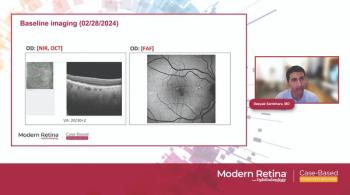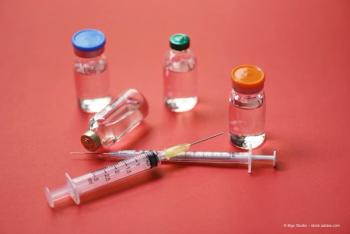
DRCR.net retinal treatment results take center stage in 2015
Studies of the efficacy of anti-vascular endothelial growth factor (VEGF), gene therapies, and slow-release drug delivery systems took center stage among treatments for retinal disorders in 2015. In addition to studies already under way, others are about to begin.
Reviewed by Julia A. Haller, MD, Mary Elizabeth Hartnett, MD, and Carl Regillo, MD
Studies of the efficacy of anti-vascular endothelial growth factor (VEGF), gene therapies, and slow-release drug delivery systems took center stage among treatments for retinal disorders in 2015. In addition to studies already under way, others are about to begin.
DRCR.net Protocols S and T
The results of the Diabetic Retinopathy Clinical Research Network (DRCR.net) Protocols S and T studies were the biggest news of the year for physicians looking for information about retinal therapy along with other clinical studies of the effects of anti-VEGF drugs.
There has been a huge shift in treating diabetic retinopathy to more pharmacologic approaches as evidenced by these two important studies, said Julia A. Haller, MD, ophthalmologist-in-chief, Wills Eye Hospital, and professor and chairperson, Department of Ophthalmology, Jefferson Medical College, Philadelphia.
In February 2015, the DRCR.net published the results of Protocol T, a 1-year comparison of the VEGF drugs ranibizumab (Lucentis, Genentech), aflibercept (Eylea, Regeneron), and bevacizumab (Avastin, Genentech) for treating diabetic macular edema.
“In the past, no trials have shown significant differences in efficacy between the anti-VEGF drugs,” Carl Regillo, MD, commented. “However, Protocol T showed that in patients with more decreased visual acuity or more severe edema, aflibercept seemed to work the best of the three drugs, i.e., a bit better than ranibizumab, which in turn was a bit better than bevacizumab, especially regarding the effectiveness in decreasing the edema.”
More specifically, Mary Elizabeth Hartnett, MD, added that the study found patients with diabetic macular edema and a visual acuity of 20/50 or worse fared better with aflibercept treatment compared with the other drugs by visual acuity, fewer lasers, and fewer injections. Still, additional research is needed for long-term effects and in terms of safety, particularly from systemic effects related to reduced systemic VEGF levels.
Generally, studies report data that are supportive of the use of anti-VEGF agents for diabetic macular edema even as a first line of therapy, which is a paradigm shift from older studies in which laser was done. Nonetheless, only about 40% of patients with diabetic macular edema are helped by anti-VEGF, so other therapies are needed. Both dexamethasone intravitreal implant (Ozurdex, Allergan) and fluocinolone acetonide intravitreal implant, (Iluvien, Alimera Sciences) have shown promising results for diabetic macular edema.
Dr. Haller echoed this by pointing to the huge shift from laser to more pharmacologic approaches for treating diabetic retinopathy.
“Laser treatment remains an important therapeutic modality and physicians are interested in clarifying how best to fit laser into treatment,” she said. “The optimum way to do so is just not evidence-based yet.”
The DRCR.net investigators published the Protocol T findings in the New England Journal of Medicine (Wells et al., 2015;372:1193-1203).
The results of the DRCR.net Protocol S study were announced at the 2015 meeting of the American Academy of Ophthalmology (AAO).
In that study, ranibizumab was observed to be non-inferior to panretinal photocoagulation after 2 years in the visual acuity outcomes achieved for treating patients with proliferative diabetic retinopathy.
“These results indicated that anti-VEGF therapies may possibly supplant laser for treating proliferative retinopathy,” Dr. Haller said. “This was very big news in 2015.”
The primary study endpoint was the mean change in the visual acuity letter score from the evaluation at baseline to that at 2 years. The investigators reported that there was a 2.8-letter improvement in visual acuity compared with baseline in the group treated with ranibizumab compared with a 0.2-letter improvement compared with baseline in the photocoagulation group. The difference reached significance (p < 0.001).
The results of the randomized multicenter clinical trial were published online in the Journal of the American Medical Association (Writing Committee for the Diabetic Retinopathy Clinical Research Network. Nov. 13, 2015. doi:10.1001/jama.2015.15217).
Jeffrey Gross, MD, who presented the results at the AAO meeting, commented that in patients with diabetic macular edema, ranibizumab was better than panretinal photocoagulation for preserving the central and peripheral visual function, “but cost, follow-up compliance, and patient preference need to be considered.”
The investigators plan to follow the patients out to 5 years to determine the stability of the findings.
“There also may be a clinical difference, as suggested by some clinical trials, in the safety profiles based on which anti-VEGF drug is used to treat these patients,” commented Dr. Hartnett, who is professor of ophthalmology, John A. Moran Eye Center, Salt Lake City.
Recent evaluations of anti-VEGF drugs
The systemic effects of anti-VEGF drugs have been under discussion since physicians started to administer them routinely. The results of a recent study conducted at the Singapore National Eye Center evaluated the safety profiles of anti-VEGF drugs in patients with age-related macular degeneration, Ng et al. reported in the American Journal of Ophthalmology (2015;159:557-564). The investigators reported that heart attacks, strokes, and mortality rates in patients receiving intravitreal anti-VEGF therapy did not differ from the incidence rates in the general population. However, more studies are needed to confirm this finding.
In contrast, a meta-analysis from late 2014 performed by Ueda et al. (Ophthalmology. 2014;121:2193-2203) showed that generally there was an increased risk of stroke in patients receiving more ranibizumab therapy, according to Dr. Hartnett.
“Patients with AMD treated with ranibizumab had an increased risk of serious adverse events related to inhibition of VEGF when they were treated intensively with the drug in high doses every month,” she commented.
“These risks of systemic adverse events remind physicians to be cognizant of the possible adverse effects systemically from intravitreal injections and identify better, more targeted treatments for retinal disorders,” she advised.
Other multicenter studies of anti-VEGF drugs are the phase I Pediatric Eye Disease Investigative Group (PEDIG) that is seeking to determine the appropriate dose of bevacizumab for treating type 1 ROP (severe ROP) and a study by Novartis that will compare ranibizumab to laser therapy for type 1 ROP. The PEDIG study is currently recruiting patients and the Novartis study has not yet begun recruitment.
In February 2015, the FDA expanded the use of ranibizumab 0.3 mg by approving the drug for treating diabetic retinopathy and not onlyfor AMD and diabetes, according to Dr. Haller. “This is considered a significant therapeutic step for these patients,” she said.
The following month, Eylea was also granted FDA approval for treating diabetic retinopathy in patients with diabetic macular edema.
Gene therapy and drug delivery systems
In an important 2014 study in stem cell research, stem cell-derived retinal pigment epithelium cells injected under the retina were found to be safe and potentially beneficial for treating advanced dry AMD and advanced Stargardt’s macular dystrophy. Carl Regillo, MD, was part of this research that was published in The Lancet (Schwartz et al. 2015;385:509–516).
The investigators said the study provided “the first evidence of the medium-term to long-term safety, graft survival, and possible biological activity of pluripotent stem cell progeny in individuals with any disease.” They said the results suggest that human embryonic stem cell-derived RPE cells could be a new source of cells for treating medical disorders requiring tissue repair or replacement.
Dr. Regillo noted the study is now entering phase II trials for dry AMD and Stargardt’s disease, while other projects also are under way.
The phase III results for gene therapy to treat Leber’s congenital amaurosis, which is a form of inherited retinitis pigmentosa (RP), were also released in 2015. In October, Spark Therapeutics announced the phase III results of gene therapy using SPK-RPE65. The investigators found that patients treated with the gene therapy achieved significant improvement in functional vision and light sensitivity compared with the controls. 31 patients with confirmed RPE65 gene mutations met the study’s primary endpoint of the change in the bilateral mobility test score and the first two of three secondary endpoints, i.e., full-field light sensitivity threshold testing and the change in the first eye mobility test score. The patients did not meet the third secondary endpoint of visual acuity, according to the investigators.
“This is very exciting technology and could very well be the first gene therapy in medicine,” Dr. Regillo said.
Dr. Hartnett also believes this line of research is exciting and promising because of the safe, targeted nature of the treatment. With a subretinal injection, the RPE65 gene can specifically target the RPE cells because the gene is present in the eye exclusively and is not expressed in other areas of the body.
Another area of gene therapy under investigation is in the delivery of VEGF therapy for wet AMD. The phase I/II results in this area are promising, but phase II is pending due to unresolved protocol issues, Dr. Regillo noted.
Avalanche Biotechnologies conducted a phase I, 52-week trial of rAAV.sFLT-1 gene therapy for treating wet AMD. The study sought to evaluate the safety of rAAV.sFLT-1 that is administered in one subretinal injection. The results indicated that rAAV.sFLT-1 was safe, well tolerated, and supported ocular gene therapy as a potential long-term treatment option for wet AMD. The results were published in The Lancet (Rakoczy et al. DOI: http://dx.doi.org/10.1016/S0140-6736(15)00345-1). It is anticipated the study will enter phase II soon, Dr. Regillo said .
Dr. Regillo also sees slow-release delivery platforms as the future of therapeutics. This year was the first in which such technologies began entering phase II trials.
A phase II trial began in 2015 of the port delivery system from Genentech. The Long-Acting Delivery of ranibizumab, referred to as the LADDER Study, is designed to evaluate the safety and efficacy of the ranibizumab (Lucentis, Genentech, Inc.) port delivery system implant that will provide continuous drug delivery for treating patients with wet AMD. The goals of the study are to both provide patients with maximal treatment benefits and reduce the treatment burden by reducing the numbers of office visits and intraocular injections.
Another such study for wet AMD is a phase II trial being conducted by Neurotech of the encapsulated cell technology device, which is a slow-release anti-VEGF technology.
“The studies starting in 2015 put ophthalmologists in a good position to achieve some significant advances in the upcoming years,” Dr. Regillo commented.
Sirolimus for uveitis
Intravitreal administration of the sirolimus (DE-109, Santen Pharmaceutical Co.) significantly reduced vitreous haze in patients with noninfectious uveitis of the posterior segment. The vision was preserved and the safety profile was good, according to the results of the Study Assessing double-masKed Uveitis tReAtment (SAKURA), Dr. Haller said.
The primary efficacy endpoint was the vitreous haze score. The investigators found that more patients treated with sirolimus 440 micrograms had a haze score of zero compared with those treated with and 880- and 44-microgram doses (22.8% versus 16.4% and 10.3%, respectively). The drug is not yet approved by the FDA.
Julia A. Haller, MD
e: jhaller@willseye.org
Mary Elizabeth Hartnett, MD
e: me.hartnett@hsc.utah.edu
Carl Regillo, MD
e: cregillo@aol.com
Drs. Haller, Hartnett, and Regillo have no proprietary or financial interests in any products mentioned in this report.
Newsletter
Keep your retina practice on the forefront—subscribe for expert analysis and emerging trends in retinal disease management.








































